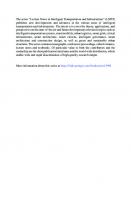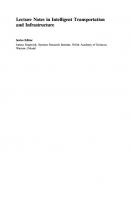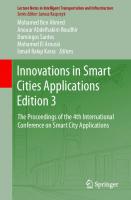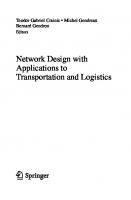Technological and Industrial Applications Associated with Intelligent Logistics (Lecture Notes in Intelligent Transportation and Infrastructure) 303068654X, 9783030686543
142 16 22MB
English Pages [638]
Table of contents :
Introduction
Contents
Industrial Logistics
Determining and Applying Productive, Environmental and Economical Indicators and Indexes to a Cyber Physical System for Greening Process of Supply Chain
1 Introduction
1.1 Industry 4.0
1.2 Circular Economy: The Way to Green Supply Chain
1.3 Key Performance Indicator for Green Supply Chain
1.4 Advantages of Applying Industry 4.0
2 Materials and Methods
2.1 Cyber-Physical System Implementation in a Machine Tool
2.2 Key Performance Indicator Definition
3 Results
3.1 Productive Dimension—Key Performance Indicator Results
3.2 Environmental Dimension—Key Performance Indicator Results
3.3 Economic Dimension—Key Performance Indicator Results
3.4 Results of the New Key Performance Indicators
4 Conclusions
4.1 Future Research
References
Design of Material Delivery Routes with Towing Equipment for the Automotive Sector Using a Von Neumann Topology of PSO Under the Logistics 4.0 Paradigm
1 Introduction
2 Formalization of the Problem
3 Proposed Methodology
4 Experimentation of Our Proposed Model
4.1 Particle Swarm Optimization
5 Conclusions and Future Research
5.1 Future Research
5.2 Simulation
References
Industrial Accident Induced Coma: A Multi-Disciplinary Perspective Within the Industry 4.0 Paradigm
1 Introduction
2 Implementation of the Intelligent Application
3 Multicriteria Analysis
4 Multivariable Analysis of Our Results
5 Conclusions and Future Research
References
Coahuila’s Future a Perspective Derived from the Growth Per Municipality to Establish a Car Assembler
1 Introduction
2 Selected Attributes
2.1 CROSSING I. Impact of the Economically Active Population on Housing with Basic Services (PEA—VPHCSERV)
2.2 CROSSING II. Impact of the Average Level of Schooling with the Economically Active Population (PEA—GRAPROES)
2.3 CROSSING III. Impact of the Total Population on the Economically Active Population (PEA—TOTAL POP)
2.4 CROSSING IV. Impact of the Total Population with the Population Entitled to Health Services (PDERSS—TOTAL POP)
2.5 CROSSING V. Impact of the Total Population with Dwellings that Have Internet Use (POBTOT—VPHINTER)
3 Multi-criteria Analysis
4 Results
5 Growth Strategies
6 Conclusions
References
Layout Problem: Optimization with Material Tour in Open Field. Case of Study
1 Introduction
2 Workshop Characteristics
3 Mathematical Model Applied for the Case Study
4 Solution Methods
5 Branch and Bound
6 Simulated Annealing
7 Application
8 Methodology
9 State of the Art
10 Data Collected
11 Results
12 Conclusion
13 Future Work
References
Waste Collection of Touristics Services Sector Residues Vehicle Routing Problem with Time Windows to an Industrial Polygon in a Smart City
1 Introduction
2 Literature Review
2.1 Algorithms Used for Waste Management
2.2 Complexity
2.3 Solution Methods
3 Model Formulation
3.1 Problem Formulation
3.2 Notation
3.3 Model Constraints
3.4 Model Construction
4 Algorithm
4.1 Algorithm Design
4.2 Initial Solution Based on Greedy Algorithm
4.3 Simulated Annealing Algorithm
5 Conclusion
6 Future Research
References
Distribution of Merchandise Through Clarke and Wright Heuristic and Mathematical Model: Case Study
1 Introduction
2 Methodology
2.1 Vehicle Routing Problem (VRP)
2.2 Clarke and Wright Heuristic
3 Case Study
3.1 Clarke and Wright Algorithm and CVRP Model Parameters
3.2 Development of the Methodology
3.3 Application of the Clarke and Wright Algorithm and Analysis of Results
3.4 Application of the Mathematical Model and Analysis of Results
4 Conclusions
References
Transport and Movements of Vehicles in a Smart City
Rethinking the Effects of Fatal Falls on an Italian Scooter in a Smart City: An Approach from Ergonomics and an Ideal and Optimal Helmet: Conditioned Helmet for Improved Security on the Road in a Smart City
1 Introduction
2 Methodology
3 Proposed Methodology
4 The Most Common Mistakes When Riding Motorcycles
5 The Function of the Helmet
6 Conclusions
7 Future Research
References
Design of an Urban Transport Network for the Optimal Location of Bus Stops in a Smart City Based on a Big Data Model and Spider Monkey Optimization Algorithm
1 Introduction
1.1 Background Relating to Transport
1.2 Description of the Problem
1.3 Justification
1.4 Research Questions
1.5 General Objective
1.6 Hypothesis
1.7 Scope and Delimitations
1.8 Contribution (Scientific, Technological and/or Industrial)
2 Theoretical Framework and State of Art
2.1 Theoretical Framework
2.2 State of the Art
3 Methodology Proposed
3.1 Proposed Solution: Implementation of the near neighbor algorithm
3.2 Validation
4 Results
5 Conclusions and Future Research
5.1 Future Research
References
Public Urban Transportation in the Smart City: An Exploratory Study in the Northern México
1 Smart City
2 Intelligent Urban Public Transportation
3 Context of Public Urban Transportation in Juárez
4 Method
5 Results
6 Concluding Remarks
References
The Difficulties and Complications of Children When Going to a Zoo and Should Interact with the Colors of the Information in It: An Approach Based on the Use of a Humanoid NAO Robot in an Application for “Smart Cities”
1 Introduction
2 Signaling at a Zoo
3 What is NAO?
4 Color Recognition
5 Results
6 Conclusions and Future Research
6.1 Future Research
References
Optimization of Route Planning for the Package Delivery Problem Using Fuzzy Clustering
1 Introduction
2 Problem Definition
3 Solution Method
3.1 Fuzzy c–Means Algorithm
3.2 Formulation for TSP
4 Computational Experiment
4.1 Experimental Conditions and Test Bed
4.2 Experimental Results and Discussion
5 Conclusions
References
State of the Art for the Creation of a Methodology for the Proper Location of Urban Truck Stops on Route 2A
1 Introduction
2 Literary Review
2.1 Transportation Network Design and Frequency Configuration
2.2 Demand
2.3 Walking Distance
2.4 Stops’ Location
3 Conclusions
References
Humanitarian Logistics
Financial Analysis Over the Smartest Companies
1 Introduction
2 Theoretical Framework
3 Methodology
3.1 Companies to Analyze
4 Data Analysis
5 Conclusion and Future Research
References
Simulating Crowd Movements During Emergency Fire Situations: Mexico City Airport Simulation Case
1 Introduction
1.1 Specific Crowd at Gate 75
2 Literature Review
3 Modeling and Simulation
3.1 Modeling Scene
3.2 Modeling Persons
3.3 Materials
3.4 Scenario Creation
4 Results
4.1 Improvements Simulation
5 Conclusions and Future Research
5.1 Future Research
References
Modular Framework for Crowd Simulation “Menge” from a Production Warehouse Simulation Perspective
1 Introduction
2 Materials
2.1 Software
2.2 Scenarios
2.3 Simulation
3 Conclusions and Future Work
References
Mobile Application for the Detection of COVID19 Suspicious Cases in Mexico Using an Intelligent Model of Virtual Patients
1 Introduction
2 Detecting Suspicious Cases
3 Conclusions
4 Future Research
References
Humanitarian Logistics for the Optimal and Timely Evacuation in High Buildings Within a Smart City Using an Adaptive Metaheuristic Context
1 Introduction
2 Theory
2.1 High Concentration in Different Building Levels
2.2 Modelling Crowds
2.3 Simulating Crowds in Fire Middle-Upper Levels of Buildings
2.4 Humanitarian Logistics in Fire Buildings
3 A Sociocultural Perspective for Simulating Human Stampedes
3.1 Architecture of System Using CUDA & FlameGPU
3.2 Experiment Design of Evacuation Proposed Model
4 Experimentation of Diverse Scenarios
4.1 Use Case of a Building of More Than 27 Levels High
4.2 Simulation Results
5 Conclusions
References
E-commerce, Marketing and Mobile Application of Logistics Including Human Factor
Using Machine Learning to Predict Online Buying Behaviour, Wholesale and Fashion Marketing at Zara, an Analysis Including Z Generation
1 Problem Statement
1.1 Research Questions
1.2 Justification
1.3 Hypothesis
1.4 Description of the Thesis Organization
1.5 Legal Framework
2 Methodology
2.1 General Objective
2.2 Participants
2.3 Scenario
2.4 Information Collection Instruments
2.5 Procedure
2.6 Method Design
2.7 Operationalisation of the Variables
2.8 Data Analysis
2.9 Ethical Considerations
3 Research Results
3.1 Result Supervised Learning Machine K-Nearest Neighbors
3.2 Naive Bayes Learning Machine Result
3.3 Result Learning Machine Neural Network
4 Experimentation
5 Conclusions and Future Research
References
Analysis of Mental Fatigue Under Delivery Pressure and Considering Creativity and Precision to Organize and Distribute a Diorama to Represent Social Issues Based on Cultural Algorithms
1 Introduction
2 Cultural Algorithms
3 Selection of Relationships in a Workforce to Determine Mental Fatigue
4 Adequate Location Selection Based on Visual Representation
5 Multiple Matching to Determinate and Evaluate the Selection on a Location in a Diorama
6 Experimentation
7 Conclusions and Future Research
References
Medicine Inventory Control System Through Fuzzy Logic and Genetic Algorithms: Applied to a Biopharmaceutical
1 Introduction
1.1 Description of Problem
1.2 Related Jobs
1.3 Theoretical Framework
2 Methodology
3 Results
4 Conclusion
References
Technical Analysis of Shipments in an Automotive Company to Forecast Sales Volumes
1 Introduction
2 Auto Market Sensors
3 Methodology
4 Forecasting Results
5 Conclusions
References
Distributed Programming Applied for the Optimization of Hydraulic Networks Through a Web Application
1 Introduction
2 Heuristics and Metaheuristics
3 Distributed Programming (DP)
4 Problem of the Water Distribution Network
4.1 Symbolic Representation of the Problem
4.2 Optimization Model
4.3 Constraints Satisfaction Model
5 Solution Methodology
5.1 Genetic Algorithm
5.2 Web Application
6 Experimental Results
7 Conclusions
References
Diverse Kind of Logistics in Amalgamed Application Domains
What is the Best Location of a Smart Airport in Juarez, Mexico?
1 Introduction
2 Cities and Development
3 Smart Cities: Competitive and Sustainable
4 Intelligent Airports: Competitive and Sustainable
5 Location Airport Analyses
6 Juárez, Mexico Airport
7 Method
8 Criterial Evaluation Areas
8.1 Proposed Location Zones
9 Results
10 Conclusions
References
Colombian Coffee Price Forecast via LSTM Neural Networks
1 Introduction
2 Literature Review
2.1 Coffee Price Dynamics
2.2 Forecast of Coffee Prices
3 Methodology
3.1 Time Series
3.2 Neural Networks
3.3 Recurrent Neural Networks
4 Implementation
4.1 Data Pre-Processing
4.2 Model Archichectures
5 Results
5.1 Forecasting
6 Conclusions
References
Some Pragmatic Prevention’s Guidelines Regarding SARS-CoV-2 and COVID-19 in Latin-America Inspired by Mixed Machine Learning Techniques and Artificial Mathematical Intelligence. Case Study: Colombia
1 Introduction
2 Understanding the Context
2.1 COVID-19: Origin
2.2 COVID-19 in Europe and the United States
2.3 COVID-19 in Latin America: Arrival, Propagation, and Mortality
2.4 COVID-19 in Colombia
3 Fundamental Methods
3.1 Opinion Mining
3.2 Artificial Mathematical Intelligence
4 Pragmatic Preventive Guidelines
4.1 Regular Creative Visualization and Effective Planning
4.2 Using Constructive Linguistic Frameworks
4.3 Frequent and Moderate Kinesthetic Routines
5 General Conclusions
Appendix
References
A Drone System for Detecting, Classifying and Monitoring Solid Wastes Using Computer Vision Techniques in the Context of a Smart Cities Logistics Systems
1 Introduction
2 Motivation
3 State of the Art
4 Materials and Method
4.1 Dataset Collection
4.2 Model Training
4.3 Model Validation
5 Integration of the Computer Vision Model into the Drone System
5.1 Integration of Cameras in UAV Navigation Systems
6 Discussion: Use of Drones into Smart City Logistics
7 Conclusion
References
Geo-Referenced Correlation for a Fire in a Smart City Urban Forest Using Hybrid Drone Data and Satellite Images
1 Introduction
2 Implementation of the Intelligent Application
3 Test Development of a Mobile Device and Our Proposal Heterogeneous Drone Cluster
4 DERT Algorithm
4.1 The Drone Prioritization Phase
4.2 The Assignment Phase of a Sub-area
5 Simulation
6 Conclusions and Future Research
References
Evaluation of Drones for Inspection and Control in Industry 4.0
1 Introduction
2 Models of the Interface
3 Drone Applications
4 The TOPSIS Method
5 MOORA Versus TOPSIS
6 Carbon Footprint
7 NOM-035 STPS 2018
References
Uncertain Analysis Based on Milk-Runs Systems Using Bayesian Networks
1 Introduction
2 Problem Statement
3 Literature Review
4 Methodology
5 Case of study
6 Results and Analysis
7 Conclusions
7.1 Future Work
References
Implementation of an Intelligent Visual Recognition System for the Proper Classification of Solid Waste Using a Mobile Application in a Smart City
1 Introduction
2 Motivation
3 State of the Art
4 Materials and Method
4.1 Dataset Collection
4.2 Dataset Preprocessing
4.3 Model Training
4.4 Model Validation
5 Integration into of an Intelligent Mobile Device Application
6 Discussion: Use of Intelligent Mobile Device Application to Improve the Competitiveness into Life Citizens on a Smart City
7 Conclusion and Future Research
References
Logistics on the Designing of an Electronic Colorblindness Application for Early Colorblindness Detection in Children by Using a Modified Ishihara Test
1 Introduction
2 Backgrounds
3 Development
4 Results
5 Conclusions
6 Future Work
References
Introduction
Contents
Industrial Logistics
Determining and Applying Productive, Environmental and Economical Indicators and Indexes to a Cyber Physical System for Greening Process of Supply Chain
1 Introduction
1.1 Industry 4.0
1.2 Circular Economy: The Way to Green Supply Chain
1.3 Key Performance Indicator for Green Supply Chain
1.4 Advantages of Applying Industry 4.0
2 Materials and Methods
2.1 Cyber-Physical System Implementation in a Machine Tool
2.2 Key Performance Indicator Definition
3 Results
3.1 Productive Dimension—Key Performance Indicator Results
3.2 Environmental Dimension—Key Performance Indicator Results
3.3 Economic Dimension—Key Performance Indicator Results
3.4 Results of the New Key Performance Indicators
4 Conclusions
4.1 Future Research
References
Design of Material Delivery Routes with Towing Equipment for the Automotive Sector Using a Von Neumann Topology of PSO Under the Logistics 4.0 Paradigm
1 Introduction
2 Formalization of the Problem
3 Proposed Methodology
4 Experimentation of Our Proposed Model
4.1 Particle Swarm Optimization
5 Conclusions and Future Research
5.1 Future Research
5.2 Simulation
References
Industrial Accident Induced Coma: A Multi-Disciplinary Perspective Within the Industry 4.0 Paradigm
1 Introduction
2 Implementation of the Intelligent Application
3 Multicriteria Analysis
4 Multivariable Analysis of Our Results
5 Conclusions and Future Research
References
Coahuila’s Future a Perspective Derived from the Growth Per Municipality to Establish a Car Assembler
1 Introduction
2 Selected Attributes
2.1 CROSSING I. Impact of the Economically Active Population on Housing with Basic Services (PEA—VPHCSERV)
2.2 CROSSING II. Impact of the Average Level of Schooling with the Economically Active Population (PEA—GRAPROES)
2.3 CROSSING III. Impact of the Total Population on the Economically Active Population (PEA—TOTAL POP)
2.4 CROSSING IV. Impact of the Total Population with the Population Entitled to Health Services (PDERSS—TOTAL POP)
2.5 CROSSING V. Impact of the Total Population with Dwellings that Have Internet Use (POBTOT—VPHINTER)
3 Multi-criteria Analysis
4 Results
5 Growth Strategies
6 Conclusions
References
Layout Problem: Optimization with Material Tour in Open Field. Case of Study
1 Introduction
2 Workshop Characteristics
3 Mathematical Model Applied for the Case Study
4 Solution Methods
5 Branch and Bound
6 Simulated Annealing
7 Application
8 Methodology
9 State of the Art
10 Data Collected
11 Results
12 Conclusion
13 Future Work
References
Waste Collection of Touristics Services Sector Residues Vehicle Routing Problem with Time Windows to an Industrial Polygon in a Smart City
1 Introduction
2 Literature Review
2.1 Algorithms Used for Waste Management
2.2 Complexity
2.3 Solution Methods
3 Model Formulation
3.1 Problem Formulation
3.2 Notation
3.3 Model Constraints
3.4 Model Construction
4 Algorithm
4.1 Algorithm Design
4.2 Initial Solution Based on Greedy Algorithm
4.3 Simulated Annealing Algorithm
5 Conclusion
6 Future Research
References
Distribution of Merchandise Through Clarke and Wright Heuristic and Mathematical Model: Case Study
1 Introduction
2 Methodology
2.1 Vehicle Routing Problem (VRP)
2.2 Clarke and Wright Heuristic
3 Case Study
3.1 Clarke and Wright Algorithm and CVRP Model Parameters
3.2 Development of the Methodology
3.3 Application of the Clarke and Wright Algorithm and Analysis of Results
3.4 Application of the Mathematical Model and Analysis of Results
4 Conclusions
References
Transport and Movements of Vehicles in a Smart City
Rethinking the Effects of Fatal Falls on an Italian Scooter in a Smart City: An Approach from Ergonomics and an Ideal and Optimal Helmet: Conditioned Helmet for Improved Security on the Road in a Smart City
1 Introduction
2 Methodology
3 Proposed Methodology
4 The Most Common Mistakes When Riding Motorcycles
5 The Function of the Helmet
6 Conclusions
7 Future Research
References
Design of an Urban Transport Network for the Optimal Location of Bus Stops in a Smart City Based on a Big Data Model and Spider Monkey Optimization Algorithm
1 Introduction
1.1 Background Relating to Transport
1.2 Description of the Problem
1.3 Justification
1.4 Research Questions
1.5 General Objective
1.6 Hypothesis
1.7 Scope and Delimitations
1.8 Contribution (Scientific, Technological and/or Industrial)
2 Theoretical Framework and State of Art
2.1 Theoretical Framework
2.2 State of the Art
3 Methodology Proposed
3.1 Proposed Solution: Implementation of the near neighbor algorithm
3.2 Validation
4 Results
5 Conclusions and Future Research
5.1 Future Research
References
Public Urban Transportation in the Smart City: An Exploratory Study in the Northern México
1 Smart City
2 Intelligent Urban Public Transportation
3 Context of Public Urban Transportation in Juárez
4 Method
5 Results
6 Concluding Remarks
References
The Difficulties and Complications of Children When Going to a Zoo and Should Interact with the Colors of the Information in It: An Approach Based on the Use of a Humanoid NAO Robot in an Application for “Smart Cities”
1 Introduction
2 Signaling at a Zoo
3 What is NAO?
4 Color Recognition
5 Results
6 Conclusions and Future Research
6.1 Future Research
References
Optimization of Route Planning for the Package Delivery Problem Using Fuzzy Clustering
1 Introduction
2 Problem Definition
3 Solution Method
3.1 Fuzzy c–Means Algorithm
3.2 Formulation for TSP
4 Computational Experiment
4.1 Experimental Conditions and Test Bed
4.2 Experimental Results and Discussion
5 Conclusions
References
State of the Art for the Creation of a Methodology for the Proper Location of Urban Truck Stops on Route 2A
1 Introduction
2 Literary Review
2.1 Transportation Network Design and Frequency Configuration
2.2 Demand
2.3 Walking Distance
2.4 Stops’ Location
3 Conclusions
References
Humanitarian Logistics
Financial Analysis Over the Smartest Companies
1 Introduction
2 Theoretical Framework
3 Methodology
3.1 Companies to Analyze
4 Data Analysis
5 Conclusion and Future Research
References
Simulating Crowd Movements During Emergency Fire Situations: Mexico City Airport Simulation Case
1 Introduction
1.1 Specific Crowd at Gate 75
2 Literature Review
3 Modeling and Simulation
3.1 Modeling Scene
3.2 Modeling Persons
3.3 Materials
3.4 Scenario Creation
4 Results
4.1 Improvements Simulation
5 Conclusions and Future Research
5.1 Future Research
References
Modular Framework for Crowd Simulation “Menge” from a Production Warehouse Simulation Perspective
1 Introduction
2 Materials
2.1 Software
2.2 Scenarios
2.3 Simulation
3 Conclusions and Future Work
References
Mobile Application for the Detection of COVID19 Suspicious Cases in Mexico Using an Intelligent Model of Virtual Patients
1 Introduction
2 Detecting Suspicious Cases
3 Conclusions
4 Future Research
References
Humanitarian Logistics for the Optimal and Timely Evacuation in High Buildings Within a Smart City Using an Adaptive Metaheuristic Context
1 Introduction
2 Theory
2.1 High Concentration in Different Building Levels
2.2 Modelling Crowds
2.3 Simulating Crowds in Fire Middle-Upper Levels of Buildings
2.4 Humanitarian Logistics in Fire Buildings
3 A Sociocultural Perspective for Simulating Human Stampedes
3.1 Architecture of System Using CUDA & FlameGPU
3.2 Experiment Design of Evacuation Proposed Model
4 Experimentation of Diverse Scenarios
4.1 Use Case of a Building of More Than 27 Levels High
4.2 Simulation Results
5 Conclusions
References
E-commerce, Marketing and Mobile Application of Logistics Including Human Factor
Using Machine Learning to Predict Online Buying Behaviour, Wholesale and Fashion Marketing at Zara, an Analysis Including Z Generation
1 Problem Statement
1.1 Research Questions
1.2 Justification
1.3 Hypothesis
1.4 Description of the Thesis Organization
1.5 Legal Framework
2 Methodology
2.1 General Objective
2.2 Participants
2.3 Scenario
2.4 Information Collection Instruments
2.5 Procedure
2.6 Method Design
2.7 Operationalisation of the Variables
2.8 Data Analysis
2.9 Ethical Considerations
3 Research Results
3.1 Result Supervised Learning Machine K-Nearest Neighbors
3.2 Naive Bayes Learning Machine Result
3.3 Result Learning Machine Neural Network
4 Experimentation
5 Conclusions and Future Research
References
Analysis of Mental Fatigue Under Delivery Pressure and Considering Creativity and Precision to Organize and Distribute a Diorama to Represent Social Issues Based on Cultural Algorithms
1 Introduction
2 Cultural Algorithms
3 Selection of Relationships in a Workforce to Determine Mental Fatigue
4 Adequate Location Selection Based on Visual Representation
5 Multiple Matching to Determinate and Evaluate the Selection on a Location in a Diorama
6 Experimentation
7 Conclusions and Future Research
References
Medicine Inventory Control System Through Fuzzy Logic and Genetic Algorithms: Applied to a Biopharmaceutical
1 Introduction
1.1 Description of Problem
1.2 Related Jobs
1.3 Theoretical Framework
2 Methodology
3 Results
4 Conclusion
References
Technical Analysis of Shipments in an Automotive Company to Forecast Sales Volumes
1 Introduction
2 Auto Market Sensors
3 Methodology
4 Forecasting Results
5 Conclusions
References
Distributed Programming Applied for the Optimization of Hydraulic Networks Through a Web Application
1 Introduction
2 Heuristics and Metaheuristics
3 Distributed Programming (DP)
4 Problem of the Water Distribution Network
4.1 Symbolic Representation of the Problem
4.2 Optimization Model
4.3 Constraints Satisfaction Model
5 Solution Methodology
5.1 Genetic Algorithm
5.2 Web Application
6 Experimental Results
7 Conclusions
References
Diverse Kind of Logistics in Amalgamed Application Domains
What is the Best Location of a Smart Airport in Juarez, Mexico?
1 Introduction
2 Cities and Development
3 Smart Cities: Competitive and Sustainable
4 Intelligent Airports: Competitive and Sustainable
5 Location Airport Analyses
6 Juárez, Mexico Airport
7 Method
8 Criterial Evaluation Areas
8.1 Proposed Location Zones
9 Results
10 Conclusions
References
Colombian Coffee Price Forecast via LSTM Neural Networks
1 Introduction
2 Literature Review
2.1 Coffee Price Dynamics
2.2 Forecast of Coffee Prices
3 Methodology
3.1 Time Series
3.2 Neural Networks
3.3 Recurrent Neural Networks
4 Implementation
4.1 Data Pre-Processing
4.2 Model Archichectures
5 Results
5.1 Forecasting
6 Conclusions
References
Some Pragmatic Prevention’s Guidelines Regarding SARS-CoV-2 and COVID-19 in Latin-America Inspired by Mixed Machine Learning Techniques and Artificial Mathematical Intelligence. Case Study: Colombia
1 Introduction
2 Understanding the Context
2.1 COVID-19: Origin
2.2 COVID-19 in Europe and the United States
2.3 COVID-19 in Latin America: Arrival, Propagation, and Mortality
2.4 COVID-19 in Colombia
3 Fundamental Methods
3.1 Opinion Mining
3.2 Artificial Mathematical Intelligence
4 Pragmatic Preventive Guidelines
4.1 Regular Creative Visualization and Effective Planning
4.2 Using Constructive Linguistic Frameworks
4.3 Frequent and Moderate Kinesthetic Routines
5 General Conclusions
Appendix
References
A Drone System for Detecting, Classifying and Monitoring Solid Wastes Using Computer Vision Techniques in the Context of a Smart Cities Logistics Systems
1 Introduction
2 Motivation
3 State of the Art
4 Materials and Method
4.1 Dataset Collection
4.2 Model Training
4.3 Model Validation
5 Integration of the Computer Vision Model into the Drone System
5.1 Integration of Cameras in UAV Navigation Systems
6 Discussion: Use of Drones into Smart City Logistics
7 Conclusion
References
Geo-Referenced Correlation for a Fire in a Smart City Urban Forest Using Hybrid Drone Data and Satellite Images
1 Introduction
2 Implementation of the Intelligent Application
3 Test Development of a Mobile Device and Our Proposal Heterogeneous Drone Cluster
4 DERT Algorithm
4.1 The Drone Prioritization Phase
4.2 The Assignment Phase of a Sub-area
5 Simulation
6 Conclusions and Future Research
References
Evaluation of Drones for Inspection and Control in Industry 4.0
1 Introduction
2 Models of the Interface
3 Drone Applications
4 The TOPSIS Method
5 MOORA Versus TOPSIS
6 Carbon Footprint
7 NOM-035 STPS 2018
References
Uncertain Analysis Based on Milk-Runs Systems Using Bayesian Networks
1 Introduction
2 Problem Statement
3 Literature Review
4 Methodology
5 Case of study
6 Results and Analysis
7 Conclusions
7.1 Future Work
References
Implementation of an Intelligent Visual Recognition System for the Proper Classification of Solid Waste Using a Mobile Application in a Smart City
1 Introduction
2 Motivation
3 State of the Art
4 Materials and Method
4.1 Dataset Collection
4.2 Dataset Preprocessing
4.3 Model Training
4.4 Model Validation
5 Integration into of an Intelligent Mobile Device Application
6 Discussion: Use of Intelligent Mobile Device Application to Improve the Competitiveness into Life Citizens on a Smart City
7 Conclusion and Future Research
References
Logistics on the Designing of an Electronic Colorblindness Application for Early Colorblindness Detection in Children by Using a Modified Ishihara Test
1 Introduction
2 Backgrounds
3 Development
4 Results
5 Conclusions
6 Future Work
References

- Author / Uploaded
- Alberto Ochoa-Zezzatti









